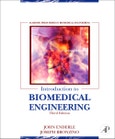Introduction to Biomedical Engineering is a comprehensive survey text for biomedical engineering courses. It is the most widely adopted text across the BME course spectrum, valued by instructors and students alike for its authority, clarity and encyclopedic coverage in a single volume.
Biomedical engineers need to understand the wide range of topics that are covered in this text, including basic mathematical modeling; anatomy and physiology; electrical engineering, signal processing and instrumentation; biomechanics; biomaterials science and tissue engineering; and medical and engineering ethics.
Enderle and Bronzino tackle these core topics at a level appropriate for senior undergraduate students and graduate students who are majoring in BME, or studying it as a combined course with a related engineering, biology or life science, or medical/pre-medical course.
- NEW: Each chapter in the 3rd Edition is revised and updated, with new chapters and materials on compartmental analysis, biochemical engineering, transport phenomena, physiological modeling and tissue engineering. Chapters on peripheral topics have been removed and made avaialblw online, including optics and computational cell biology
- NEW: many new worked examples within chapters
- NEW: more end of chapter exercises, homework problems
- NEW: image files from the text available in PowerPoint format for adopting instructors
- Readers benefit from the experience and expertise of two of the most internationally renowned BME educators
- Instructors benefit from a comprehensive teaching package including a fully worked solutions manual
Table of Contents
1. Biomedical Engineering: A Historical Perspective2. Moral and Ethical Issues
3. Anatomy and Physiology
4. Biomechanics
5. Biomaterials
6. Tissue Engineering
7. Compartmental Modeling
8. Biochemical Reactions and Enzyme Kinetics
9. Bioinstrumentation
10. Biomedical Sensors
11. Biosignal Processing
12. Bioelectric Phenomena
13. Physiological Modeling
14. Biomedical Transport Processes
15. Radiation Imaging
16. Medical Imaging
17. Biomedical Optics and Lasers








